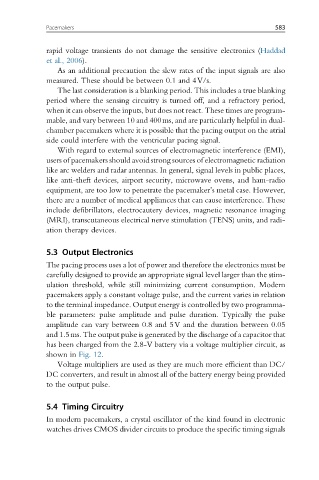Page 592 - Handbook of Biomechatronics
P. 592
Pacemakers 583
rapid voltage transients do not damage the sensitive electronics (Haddad
et al., 2006).
As an additional precaution the slew rates of the input signals are also
measured. These should be between 0.1 and 4V/s.
The last consideration is a blanking period. This includes a true blanking
period where the sensing circuitry is turned off, and a refractory period,
when it can observe the inputs, but does not react. These times are program-
mable, and vary between 10 and 400ms, and are particularly helpful in dual-
chamber pacemakers where it is possible that the pacing output on the atrial
side could interfere with the ventricular pacing signal.
With regard to external sources of electromagnetic interference (EMI),
users of pacemakers should avoid strong sources of electromagnetic radiation
like arc welders and radar antennas. In general, signal levels in public places,
like anti-theft devices, airport security, microwave ovens, and ham-radio
equipment, are too low to penetrate the pacemaker’s metal case. However,
there are a number of medical appliances that can cause interference. These
include defibrillators, electrocautery devices, magnetic resonance imaging
(MRI), transcutaneous electrical nerve stimulation (TENS) units, and radi-
ation therapy devices.
5.3 Output Electronics
The pacing process uses a lot of power and therefore the electronics must be
carefully designed to provide an appropriate signal level larger than the stim-
ulation threshold, while still minimizing current consumption. Modern
pacemakers apply a constant voltage pulse, and the current varies in relation
to the terminal impedance. Output energy is controlled by two programma-
ble parameters: pulse amplitude and pulse duration. Typically the pulse
amplitude can vary between 0.8 and 5V and the duration between 0.05
and 1.5ms. The output pulse is generated by the discharge of a capacitor that
has been charged from the 2.8-V battery via a voltage multiplier circuit, as
shown in Fig. 12.
Voltage multipliers are used as they are much more efficient than DC/
DC converters, and result in almost all of the battery energy being provided
to the output pulse.
5.4 Timing Circuitry
In modern pacemakers, a crystal oscillator of the kind found in electronic
watches drives CMOS divider circuits to produce the specific timing signals

